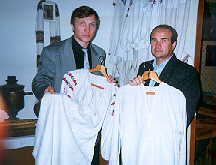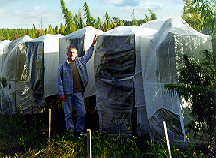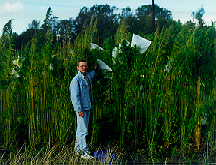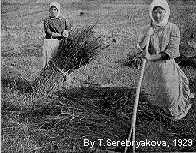 |
Hemp (Cannabis sativa L.) genetic resources at the VIR: From the collection of seeds, through the collection of sources, towards the collection of donors of traits |
| Dr. Sergey Grigoryev |
 |
Hemp is one of the most valuable and ancient crops ever cultivated. Its utilisation is very diverse: manufacture of various fabrics, paper, construction materials, medicaments, cosmetics, confectionery, etc.
 |
|
Dr. Sergey Grigoryev (left) and Director of Agicultural college Dr. Alexander Miroshnikov (right). Belgorod province, 1998 |
Hemp has been cultivated for a very long times over the territory of Russia since XI-th century and was used both for fiber (apparel and ropes) and oil. The crop was the main item of Russian export during 1758-1762 (32000 tonnes per year), standing side by side with cereals [3]. Export of hemp oil from Russia was stopped by 1900 because of high consumption of the oil within country. It was the main source of edible fats for peasants in Central Russia seventy ears ago, instead of rare beef and pork fats.
The main cultivation areas were in Central Russia. The largest area of cultivation - 816910 hectares was achieved in 1925. In the North of the country hemp has been cultivated near the Northern Border of Agriculture (66°N, approx.). Now, the area of cultivation is about 10000 hectares in Russia.The present situation is conditioned by various factors. Hemp cultivation was limited by high level of labour expenditure and narcotic problems, especially in the last years.
Our textile industry in recent years was based on raw cotton from Middle Asia. Now, when the country was cut off from raw cotton cultivation areas, significance of bast crops has ever more increased. That's why now in Russia we try to reorientate our agriculture on the production of our own fiber crops. For several years we've been carrying out trials on cultivation and breeding cotton in southern regions of the country.
Cannabis collection in VIR
 The germplasm collection preserved at the Vavilov Institute of Plant Industry (VIR) is a source of rich genetic diversity in hemp. Founded in 1922, the Institute's hemp collection was arranged under the leadership of N.I. Vavilov. The first hemp germplasm collected and preserved were diverse landraces and local strains from all over the territory of the former Soviet Union, beginning from the northernmost regions of the European part of Russia to the southern and easternmost areas of the country. Those accessions, being the result of many centuries of folk breeding, are well adapted to different local environments: short summer, frosts, droughts, etc. Numerous collecting missions of VIR to foreign countries have collected wide diversity of indigenous forms, local landraces and cultivars from China, Afghanistan, Turkey, Italy, Yugoslavia, Hungary, Bulgaria, Germany and other countries. Besides the collection has been enriched by intensive exchange of genetic resources with scientists and breeders from different countries. Now, we are ready for continuation of intensive exchange of accessions with scientists all over the World. Besides of the exchange of seeds, VIR is ready for close scientific joined co-operation in evaluation and breeding.
The germplasm collection preserved at the Vavilov Institute of Plant Industry (VIR) is a source of rich genetic diversity in hemp. Founded in 1922, the Institute's hemp collection was arranged under the leadership of N.I. Vavilov. The first hemp germplasm collected and preserved were diverse landraces and local strains from all over the territory of the former Soviet Union, beginning from the northernmost regions of the European part of Russia to the southern and easternmost areas of the country. Those accessions, being the result of many centuries of folk breeding, are well adapted to different local environments: short summer, frosts, droughts, etc. Numerous collecting missions of VIR to foreign countries have collected wide diversity of indigenous forms, local landraces and cultivars from China, Afghanistan, Turkey, Italy, Yugoslavia, Hungary, Bulgaria, Germany and other countries. Besides the collection has been enriched by intensive exchange of genetic resources with scientists and breeders from different countries. Now, we are ready for continuation of intensive exchange of accessions with scientists all over the World. Besides of the exchange of seeds, VIR is ready for close scientific joined co-operation in evaluation and breeding.
Regretfully enough, since 1941, during the years disastrous for the country, the hemp collection suffered severe damage. A lot of priceless accessions have been lost, such as: f. jacutensis Serebr. from Yakut region (the height of plant 20-60 cm., vegetation period 60-80 days), american old varieties Kentucky, Chimington, Tochimington, violet seed coloured mutated form Simple Leaf, old varieties for oil extraction from Voronezsh and Tambov provinces of Russia. Recent efforts of VIR's staff have helped to restore just a part of this collection.
 Our efforts in maintaining the collection have faced a lot of difficulties. The period of storage of seeds in room condition is 4 years. It is possible to keep the seeds in frozen state. According to several personal communications, long-term preservation of seeds in condition of low positive temperature could change main biological traits of growing plants. Also, we have many problems in reproduction of accessions in isolated plots. We should care for number of growing plants, also preventing cross-pollination, to control weedy hemp around isolated gardens. The aim is to insure genetical uniqueness of every accession. In this way we also study various artificial isolating materials in field.
Our efforts in maintaining the collection have faced a lot of difficulties. The period of storage of seeds in room condition is 4 years. It is possible to keep the seeds in frozen state. According to several personal communications, long-term preservation of seeds in condition of low positive temperature could change main biological traits of growing plants. Also, we have many problems in reproduction of accessions in isolated plots. We should care for number of growing plants, also preventing cross-pollination, to control weedy hemp around isolated gardens. The aim is to insure genetical uniqueness of every accession. In this way we also study various artificial isolating materials in field.
In contrast to the former collection of 1400 accessions, at present the hemp collection consists of approximately 500 accessions from Russia and 25 foreign countries. It includes domestic and foreign local forms and landraces, old varieties, modern cultivars and breeding lines. In the collection there are 6 accessions of northern hemp, 56 of Central Russian hemp, 322 southern accessions, 94 samples of monoecious hemp and 21 wild forms.
Previous complex studying of morphological traits, biological properties, productivity parameters, technological and biochemical characters of the collection accessions helped to identify preliminary valuable traits of accessions to be used in the breeding for any purpous. For example, in the collection there are early-maturing samples of northern hemp, capable of ripening even in the Far North (vegetation period of 75-99 days). They are characterized by a smaller plant height (80-120 cm), low fibre content (15-17%), small seed (weight of 1000 seeds: 12-16 g). The VIR's northern hemp collection has been widely used in World hemp-breeding process. More than 25 main European commercial varieties of hemp were bred using VIR hemp collection. Novgorod-Seversk accession, Dwarf Northern Russian accessions from Kirov province and Siberia, Ermakovskaya landrace germplasm were used for creating monoecious and dioecious cross-bred european cultivars. [5].
Especially, we'd like to mention the success of Dr. J.C. Callaway from Finland in creation of "northern" variety of hemp FIN-314, which is characterized by valuable combination of GLA and SDA fatty acids. It was bred with participation of k-313, k-315 Northern Type accessions from the VIR's collection [2]. The tallest in the whole collection and producing the highest straw yields are late-ripening samples from China, Italy and Yugoslavia. The collection also contains accessions with high content of narcotic substances, and those practically without tetrahydrocannabinoids (THC).
Russian plant breeders have bred a number of cultivars with high fibre content (up to 34%), high fibre quality and lowered THC content, which pedigrees included hemp accessions from the VIR's collection.
Our current priorities are to proceed with studying the current state of the collection and to add the resulting data to those obtained during the past years of research. That means, first of all, to use the results of field experiments in identifying distinctive features, individual uniqueness, typical biological properties and traits valuable for breeding in certain soil and climate environments. This would provide grounds for a conclusion on phenotypic similarity and difference of accessions within each ecogeographic hemp group. Thus it would become possible to identify the existence of valuable commercial characters in different accessions, such as: early-maturing, [link he2] cold-resistance, high seed productivity [link he2], high oil content in seed, fibre percentage, resistance to afflicting pests etc., i.e. to identify Sources of Valuable Properties available in the hemp collection.
We are planning to use the accessions, identified as the Sources of Traits, in polytest topcrosses. The results of studying the hybrids will help to identify direct Donors of Traits proceeding from the analysis of general and specific combining ability of an accession during the breeding process targeted at a certain trait or their combination, and also to generalise ways of their utilisation. It would be possible to make a conclusion on the availability of transferring any needed trait from the germplasm collection of VIR into recipient samples as well as on the possibility to incorporate a combination of traits in newly bred hemp lines and cultivars. This will enable us not only to supply the whole world's hemp breeding and producing community with recommendations concerning valuable accessions from the VIR collection with high field performance, but also to specify which of their traits can be successfully inherited or easily combined in new genotypes.

Lately, as a result of losing Southern experiment stations where late thermophilous hemp accessions were maintained, our efforts in maintaining the collection have faced much greater difficulties. However, thanks to the ongoing implementation of the international VIR/IHA Project, this work is being carried out quite successfully.
For Russia, hemp is a traditional and important industrial crop. When the country was cut off from raw cotton cultivation areas, its significance has ever more increased. In this situation the value of hemp genetic resources accumulated in the VIR's genebank becomes even higher. What is needed is an intensive work to identify in the collection sources and donors of economically valuable traits and to study heritability of most important traits.
References
- Basilevskaya N.A. 1964.The theories and methods of plant introduction. Moscow University Press:77-79.
- Callaway, J.C. and T.T. Laakkonen 1996. Cultivation of Cannabis oil seed varieties in Finland. J.I.H.A. 3(1): 32-34.
- Davidyan G.G. 1972. Hemp. Leningrad: 10-11.
- Dippenaar M.C., du Toit C.L.N., Botha-Greeff M.S. 1996. Response of hemp (Cannabis sativa L.) varieties to conditions in Northwest Province, South Africa. J.I.H.A. 3(2): 63-66.
- Meijer E.P.M. de 1995. Fibre hemp cultivars: A survey of origin, ancestry, availability and brief agronomic characteristics J.I.H.A. 2(2): 66-73.
- Hemp. 1978.Edited by prof. Senchenko G.I. Moscow. ”Kolos”: 32-34.
- Serebriakova T. 1929 . Hemp. Leningrad: 14-15, 62.
- Sustrina V.E. 1971. Modern agriculture of hemp.Penza Preess Branch: 17-18.
|
 |